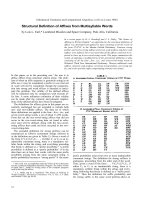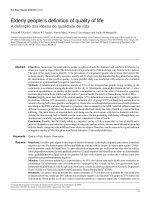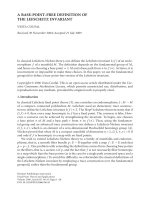Scouring - Definition of Scouring
Bạn đang xem bản rút gọn của tài liệu. Xem và tải ngay bản đầy đủ của tài liệu tại đây (546.36 KB, 41 trang )
SCOURING
Name : MAZADUL HASAN SHESHIR
ID: 2010000400008
Batch: 13th Batch (Session 2009-2013)
Department: Wet Processing Technology
Email:
Blog: www. Textilelab.blogspot.com
Southeast University
Department of Textile Engineering
PREPARED BY
©right
SCOURING
Natural fibers contain oils, fats, waxes, minerals, leafy matter and motes as
impurities that interfere with dyeing and finishing. Synthetic fibers contain
producer spin finishes, coning oils and/or knitting oils. Mill grease used to
lubricate processing equipment mill dirt, temporary fabric markings and the like
may contaminate fabrics as they are being produced. The process of
removing these impurities is called Scouring.
Even though these impurities are not soluble in water, they can be removed
by Extraction, dissolving the impurities in organic solvents, Emulsification,
forming stable suspensions of the impurities in water and Saponification,
Converting the contaminates into water soluble components.
Definition:
The tern scouring applies to the removal of impurities such as oil, wax gum,
soluble impurities and solid dirt commonly found in textile material. The process
consists essentially of treatment with alkali, a good supply of water is essential.
Scouring:
Types of Scouring Treatments :
1. Scouring By Chemicals Means
2. Bio scouring or scouring with Enzymes
Objects: - The main object of this process is to iron the fabric.
1. To remove natural as well as added impurities of essentially hydrophobic
character as completely as possible.
2. To increase absorbency of textile materials.
3. To leave the fabric in a highly hydrophilic condition without undergoing
physical or chemical treatment or damage.
4. Remove all natural impurities such as oil , wax , fat etc from the surface
of the fabric .
5. Produce the fabric more hydrophilic.
6. Increasing the absorbency and clean the fabric by use alkaline.
7. To make the suitable situation for next bleaching, dyeing, printing, and
finishing process.
8. Removing the natural coloring matter of the cotton fabric.
Objects Of Scouring:
Theory:
Scouring is the process which is removes all the natural impurities like oil wax fat
etc, from the surface of the fabric and produce the fabric more hydrophilic,
Scouring done by using alkali such as NaoH & Na2Co3. Natural impurities of
cellulosic fabric are normally removed by boiling off in a strong alkaline solution.
The main object of scouring cotton fabrics is to remove natural as well as
added impurities of essentially hydrophobic character as completely as possible
and leave the fabric in a highly absorptive condition without undergoing chemical
or physical damage significantly.
3C17 – COOH + 3NaOH= 3C17H35COONa +3H2O
Or Oil + Caustic =Soap + Glycerine
There are three types of scouring:
Saponification
Emulsification
Detergency
Method: Saponification method is used for this experiment.
Theory Of Scouring:
SCOURING BLEACHING CURVE
Chemical Use
Caustic (NaOH) Neutralize acidic materials, saponify glycerides (Waxes and
Oils), and solubilize silicate.
Sodium Silicate Penetrate and break down lignins in motes.
Surfactant Reduces surface tension and minimize interfacial tensions.
Detergent Emulsify oils, fats, and waxes; remove oil – borne stains;
suspend materials after they have been removed.
Chelating
(Sequestering) agent
Deactivate metal ions.
Builder (Salt) Cause detergents to become increasingly effective.
Solvent Assist emulsification by dissolving oily materials.
Chemical Used and Purpose:
Scouring process depends on: -
1. The type of cotton.
2. The color of cotton.
3. The cleanliness of cotton.
4. The twist and count of the yarn.
5. The construction of the fabric.
Scouring process depends on: -
Yarns and fabrics may be dirty, contain natural waxes or oils, or have been treated
with size or lubricants used in spinning, weaving or knitting.
These can all interfere with dyeing, often leading to non-level results. Scouring is a
large topic, and the process used depends on the fibre type and its condition.
“True” scouring of greige cellulosic fabrics is typically done, after desizing, at the
boil or at higher temperature in pressure vessels, with as much as 10 grams
sodium hydroxide per litre of water, plus surfactants, and the process may last for
several hours.
Commercial scouring of wool may use solvents, similar to dry cleaning, as part of
the process. White fabrics sold at retail have normally be scoured at the mill;
“natural” fabrics usually have not (some “natural” fabrics have been scoured but
not bleached).
SCOURING
SCOURING
Art dyeing literature often refers to what amounts to laundering as scouring.
This is inadequate for greige fabrics, but often quite acceptable for “white
goods”.
A long machine wash with the hottest water possible, about a gram of soda ash
per litre of water (about a teaspoon per gallon) and some (preferably optical
brightener free) detergent, followed by two rinses is usually acceptable.
Sodium hexametaphosphate may be helpful if the water is hard. Woven white
cottons often contain starch that will not be removed by such a limited
process.
Theory of Scouring:
Natural fibers contain oils, fats, waxes, minerals, leafy matter and motes as
impurities that interfere with dyeing and finishing. Synthetic fibers contain
producer spin finishes, coning oils and/or knitting oils. Mill grease used t o
lubricate processing equipment mill dirt, temporary fabric markings and the
like may contaminate fabrics as they are being produced. The process of
removing these impurities is called Scouring.
Even though these impurities are not soluble in water, they can be removed by
Extraction, dissolving the impurities in organic solvents, Emulsification, forming
stable suspensions of the impurities in water and Saponification, Converting
the contaminates into water
Theory of Scouring
SN SCOURING AGENT CHEMICALS
1 Alkaline agents
NaOH, KOH, Na2CO3, Liquid NH3
sod. metasilicate, sod. silicate, sod. phosphate,
trisodium phosphate, tetrasodium phosphate,
sodium tripolyphosphate and borax
2 Surfactants
Anionic activator, non-ionic activator
3 Organic solvent
Chlorine system: Carbonate trichloride,
trichloroethylene, perchloro ethylene, methyl
chloroform, trichloro methane, fluorine
Hydrocarbon system: Benzene, industrial gasoline,
white spirit, solvent naphtha
SCOURING AGENT
Impurities Mechanism of impurity removal
Fats and waxes
Saponification: The saponifiable parts of waxes (fatty acid,
glycerides, and esters) are converted in to soap.
Emulsification: The non-saponifiable parts of the waxes
such as alcohols and hydrocarbons are emulsified by the
soap formed.
High temperature: melts some of the waxy materials and
converts some of it to a water soluble form.
In extreme cases the use of solvent is necessary.
Pectin and related
substances
Solubilisation: by the action of alkali, which also acts as a
swelling agent to facilitate removal
Pectins are converted to water soluble salts of pectic or
meta-pectic acid
Proteins and amino
acids
Hydrolysis: Proteins are hydrolysed with the formation of
soluble sodium salts of amino acid.
Hemicelluloses
Dissolution: Hemicelluloses with low DP are dissolved in NaOH.
Inorganic substances,
minerals and heavy
metals
Partially dissolve in NaOH
By use of sequestering or chelating agents.
By producing more soluble salt e.g acid demineralisation
IMPURITIES OF SUBSTRATE
A typical adopted approach in past towards Enzymatic Scouring
process of cotton fabrics
An illustration of various steps identified to achieve fast and efficient
Enzymatic Cotton Scouring process.
Procedure of Scouring Process:
Procedure of Scouring Process:
The main processes occurring during scouring are:
1. Saponification of fats into water-soluble soap and water-miscible glycerin under alkaline
conditions,
2. Hydrolysis of proteins into water-soluble degradation products,
3. Dissolution of hydrolysis to ammonia of simpler amino compounds,
4. Conversion of pectose and pectin into their soluble salts,
5. Dissolution of mineral matter,
6. Emulsification of unsaponifiable oils and waxes, and
7. Removal of dirt particles from the kier liquor by the detergent present therein
Alkaline Enzyme Scouring of Cotton Textiles
The invention relates to a process for treatment of cellulosic material, as for example, knitted or
woven cotton fabric, comprising the steps of preparing an aqueous enzyme solution comprising
pectinase, treating the cellulosic material with an effective amount of the aqueous enzyme
solution under alkaline scouring conditions; e.g., pH of 9 or above and a temperature of 50° C.
or above, in a low calcium or calcium-free environment, yielding a modification of the cellulosic
material such that exhibits an enhanced respond to a subsequent chemical treatment.
Traditionally, cotton scouring has required the use of harsh alkaline chemicals (caustic),
extreme temperatures and large volumes of water. Expenses include not only the cost of the
caustic and energy, but also the cost of treating waste water to remove residual caustic and by-
products.
Today, textile producers have a new, effective alternative to chemical scouring with the advent
of the Cottonase™ enzyme. This novel enzyme not only cleans better than chemical scouring,
but also greatly reduces the need for extensive waste water treatment and energy
consumption. The Cottonase™ enzyme is a versatile, economically viable and environmentally
friendly alternative to chemical scouring in cotton preparation.
Alkaline Enzyme Scouring of Cotton Textiles
1. Simply wash your fabric, this includes PFD fabric, in the washing machine in hot water
with Soda Ash. Do not add any fabric softeners to the wash. If you must dry your fabric
do so without any fabric softener sheets
2. Using an large enamel or stainless steel pot, fill the pot at least half full and place one
ounce of soda ash into the pot per pound of cotton or linen fabric/fiber.
3. Place fabric into water, swish it around using a stainless steel spoon.
4. Bring water to a boil!!!
5. Adjust heat to a low boil/hard simmer and allow to boil for two hours. stir the fabric
every 15 minutes or so t make sure that the fabric is being adequately scoured
6. After two hours remove from heat source, allow fabric to cool down until the fabric is
at room temperature.
7. Remove the fabric from the water and rinse.
How to Scouring Textile Fabric:
Scouring Treatments of Cotton, Silk, Wool and Synthetics Materials
Natural fibers contain oils, fats, waxes, minerals, leafy matter and motes as impurities that
interfere with dyeing and finishing. Synthetic fibers contain producer spin finishes, coning
oils and/or knitting oils, Mill grease used to lubricate processing equipment, mill dirt,
temporary fabric markings and the like may contaminate fabrics as they are being produced.
The process of removing these impurities is called Scouring. Even though these impurities are
not soluble in water, they can be removed by Extraction, dissolving the impurities in organic
solvents, Emulsification, forming stable suspensions of the impurities in water and
Saponification, Converting the contaminates into water soluble components.
Scouring is usually carried out by means of continuous or discontinuous systems, with the
same machines used for downstream treatments; temperature, processing time, pH,
concentration of reagents, depend on the fibre,whiteness required and on the machine
used.Incomplete scouring processes usually originate dyeing and printing defects due to
different degrees of wettability and to inconsistent affinity for dyes of the material.
Scouring Treatments of Cotton, Silk, Wool and Synthetics Materials
Scouring of Cotton
In the scouring process the cotton cellulose material is treated with a solution containing alkali (
soda ash and caustic soda), an anionic and/or nonionic detergent, a wetting agent, a
complexing and sequestering for the removal of metal ions and polyacrylates or
polyphosphonates as special surfactant free dispersing agents, at high temperature.
The scouring operation was conventionally done in kier machines and hence the process was
called kier boiling , but now a days the scouring is done mostly in the dyeing machines itself as a
part of combined or single operation such as scouring and bleaching.
Saponification of fats into water soluble soap and water miscible glycerin under
alkaline conditions.
Hydrolysis of proteins into water soluble degradation products.
Dissolution of amino compounds.
Solubilising of pectose and pectins by converting into soluble salts .
Dissolution and extraction of mineral matter.
Emulsification and solubilisation of natural oils and waxes.
Removal and dispersion of dirt particles and kitty by the action of alkali and detergent.
The material after scouring is more absorbent , free from natural impurities and coloring
matter.This treatment can be carried out on filaments, yarns and fabrics.
Scouring of Cotton
Scouring of Silk
The scouring of pure silk is a degumming process used to remove sericin (silk
gum) from fibroin floss. Sericin is the gummy element which keeps together the
fibroin floss and gives the silk a hard hand and dull appearance. It is carried out
on yarn, on dyed yarn, piece-dyed fabric or on products ready for printing. The
treatment, which causes a loss of weight ranging between 24 and 28%, gives the
degummed silk a lustrous appearance and a soft hand; the treatment is carried
out with soapy solutions or with buffer dissolving agents. It is also possible to use
enzymes (protease), which hydrolyses sericin.
Scouring of Silk
Scouring of Wool
On wool, the scouring process removes oils and contaminants accumulated
during upstream processing steps and can be carried out on slivers, yarns
and fabrics with solutions containing sodium carbonate with soap or
ammonia, or anionic and non-ionic surfactants, which carry out a softer
washing to avoid any damage to the fibres.
Scouring of Synthetics
The scouring process applied to synthetic fibres removes oils, lubricants and
anti-static substances, dust, contaminants and can be carried out on yarns
and fabrics (when warp yarns have been bonded, the treatment is called
debonding). It is carried out by means of surfactants, detergents and
emulsifying agents.
Scouring of Wool- Synthetics
Scouring of Polyester/Cotton Blends:
Polyester and cotton are two different fibers obtained from natural source and
made of synthetically consecutively. Because of varying physical (Length,
diameter, strength, elasticity, torsional rigidity, frictional properties) and chemical
properties (thermal properties, density, resistance to chemical agents) of these
two fibers have led to treat this blend within proper conditions.Cotton has very
good resistance to alkalis but the action of aqueous alkalis may lead an adverse
impact on polyester. It should not be pressure kier boiled in the presence of
alkalis, as these conditions favor an accelerated attack on the fiber.
Scouring of Polyester/Cotton Blends:
Typical Scouring Recipe Polyester/Cotton Blend Goods:
Wetting agent………………………………… = 0.5-1.0 g/l
Sequesterant ………………………………… = 1.0-2.0 g/l
Detergent………………………………………….= 1.0-2.0 g/l
Caustic soda 36°Be……………………………= 1.0-3.0 g/l
Soda ash……………………………………………= 1.0-4.0 g/l
Temperature…………………………………… = 90-100°C
Time………………………………………………….= 30-60 min
pH…………………………………………………….= 10.5+/-0.5
M:L…………………………………………………… = 1:10
Typical Scouring Recipe Polyester/Cotton Blend Goods:
Scouring Procedure:
1. Set the with substrate at room temperature with wetting agent,
detergent, sequestering agents, and alkalis.
2. Raise the temperature to 95-100°C @1-3°/min
3. Run the bath for 30-60 min
4. Cool down the bath temperature to 60-70°C and drop
5. Rinse twice with hot (around 60°C) and cool water.









